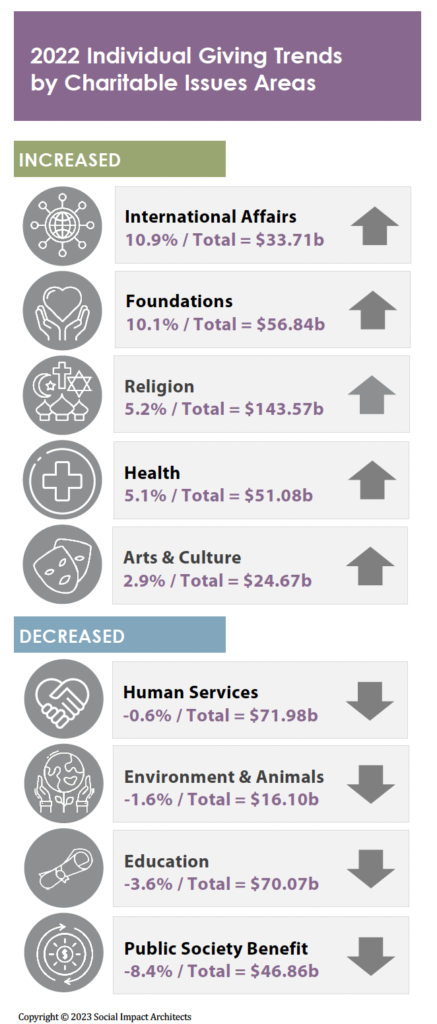 Americans have always been known for their generosity. Just as in other difficult times, Americans stepped up giving during the pandemic. Now, upon reviewing the Giving USA 2023 report – the social sector’s annual report – we saw trends that, not unexpectedly, showed declines as the economy shifts and need is not as acute. Though total giving in current dollars has declined for the first time since 2009, in inflation-adjusted dollars total giving was comparable to pre-pandemic levels. In addition, over the years the report has shown that giving bounces back from declines.
Americans have always been known for their generosity. Just as in other difficult times, Americans stepped up giving during the pandemic. Now, upon reviewing the Giving USA 2023 report – the social sector’s annual report – we saw trends that, not unexpectedly, showed declines as the economy shifts and need is not as acute. Though total giving in current dollars has declined for the first time since 2009, in inflation-adjusted dollars total giving was comparable to pre-pandemic levels. In addition, over the years the report has shown that giving bounces back from declines.
Some quick facts: In 2022, Americans gave almost $500b ($499.33 billion) to charity, a 3.4% decline compared to 2021. If you adjust this for inflation, the decline was 10.5%. The good news is that most issue areas received at or above their past funding levels. The areas that saw increases aligned with original donor preferences.
As for the sources of generosity, individuals still lead the pack (with 64% of all giving) – but as expected, this declined by 6.4%. After individuals, foundations also rallied during the pandemic and continued their strong support of charities, accounting for 21% of charitable giving (an increase of 2.5%). In fact, more than $1 of every $5 of charitable giving comes from foundations. Corporations also increased giving by 3.4%, and we expect their influence to grow. Bequests also continue to increase (9% of total with a 2.3% increase), which show that the generational wealth transfer is happening as expected.
In partnership with Heather Quinn of Wise Resource Development, we wanted to share our reflections on today’s giving trends and provide practical steps to mitigate risk, especially as we expect declines to continue into this year (if forecasts are correct).
Idea #1: Seek unrestricted gifts
Inflation has challenged both sides of philanthropy, donors and nonprofit organizations. With operating expenses stretched, your fundraising strategy should be to pursue fewer restrictions with gifts to maximize your financial flexibility. For example, if in the past, you relied on project- or program-based requests, begin to shift your language to a more holistic picture of the impact your organization provides. Individual donations are typically the most flexible, and as they still account for the largest portion of total giving, seeking individual gifts should be your priority. If you have a foundation funder that has typically given to a specific program, talk with them about your challenges and see if their support could be converted to an unrestricted gift this year. If not, make sure your program or project budget includes the administrative costs needed to oversee the program.
Idea #2: Make stewardship non-negotiable
Individual donors are no longer actively looking for new places to help like they were at the height of the pandemic. The decline in individual giving shows that it’s more important than ever to focus on retention. You should have a calendar of touchpoints with every donor throughout the year, with a frequency based on each donor’s preferences. To make the process easier, Wise Resource Development shared some strategies to automate your stewardship while keeping your communications personal and customized. Though resources may be tight, it’s important to remember that acquiring a new donor costs 10 times what it takes to keep an existing one, and with these new insights, that cost may go up. Beyond that, keeping communication lines open with your major donors will ensure that if they are having financial challenges that will impact their contribution, you will be the first to know. This gives you time and space to implement gap strategies to make up for a loss.
Idea #3: Say goodbye to the cold grant proposal
Though foundation giving didn’t grow in 2022 when adjusted for inflation, foundations continue to grow their share of total charitable giving. Instead of casting a broad net of grant proposals without cultivation, seek out relationships with funders first. Wise Resource Development recently shared three ways to make your grants stand out – and the first tip is to develop a relationship with the foundation. Not only could a conversation provide insights that don’t appear on their website or in their guidelines, but making contact will ensure your proposal is recognizable and more likely to be considered for funding. Once funded, maintaining a close relationship with the funder will ensure your partnership will grow and prevent them from moving on to another organization. Additionally, while you’re facing challenges with expenses due to inflation, an open relationship with a funder will lend itself to conversations about what your greatest needs for funding really are.
Idea #4: Amplify planned/legacy giving NOW
We are currently experiencing the “Great Transfer of Wealth,” and over the next few decades financial experts are expecting that between $40 trillion and $140 trillion will be passed from one generation to the next. Up to one-third of this wealth will be transferred to nonprofits through planned giving. If you are not inviting your donors to leave a legacy in the form of planned giving to your nonprofit, you are missing out on potentially transformative funding for your mission. There are easy ways to implement a planned giving program for all levels of organizational capacity and budget sizes. Adding a statement about legacy giving on your marketing materials, requesting bequest donors self-identify and reviewing your donor data to identify planned giving prospects are just a few easy ways to implement a low-budget planned giving strategy.
Idea #5: Rethink your corporate fundraising strategy
Companies have so much untapped potential for helping be a force for good. As we have written before, the data is clear that businesses large and small want to engage in more than checkbook philanthropy or as a table sponsor at your upcoming event. We encourage nonprofits to look for a natural fit in a corporate strategic partner – either in mission (e.g., food companies supporting the local food bank) or geography (e.g., the local small businesses surrounding a school, library or church). Many nonprofits pursue funding from Fortune 500 companies because they have more financial resources, but they also receive more requests and are pulled in many directions. We encourage you to look locally to small businesses and entrepreneurs who want to commit to a long-term relationship. When you meet, pitch them an annual monetary and volunteer commitment. This could include sponsorship of your annual events, in-kind assistance of product, a guest speaker at an upcoming employee gathering, a volunteer activity to engage their employees in the mission and an opportunity for a company leader to serve on a board or strategic planning task force. Be sure to show your appreciation along the way. For example, post their partnership on your website with backlinks, feature a board member snapshot on social media, share their CSR/Corporate Citizenship annual report (with your partnership hopefully profiled) and pictures of their volunteer engagement. And my favorite value-add – when your organization gets a big win, call them and tell them about it. They were a big part in making it happen!
The pandemic upended every aspect of our lives, philanthropy included. Now is the time to reset your fundraising plan by viewing these trends through the lens of your experience and adjusting your strategies and tactics. We welcome any additional analysis on giving trends as well as any ways your organization is shifting its fundraising efforts.

